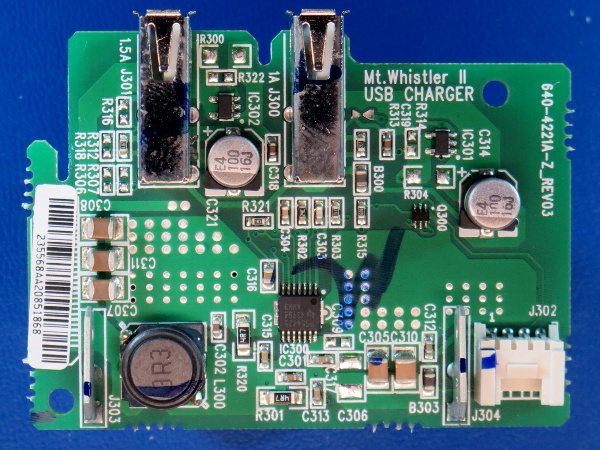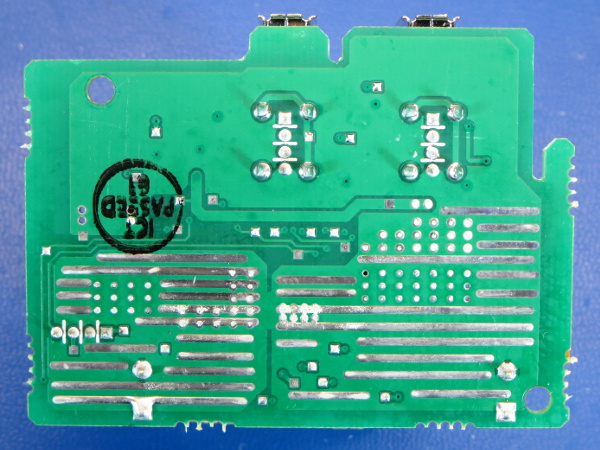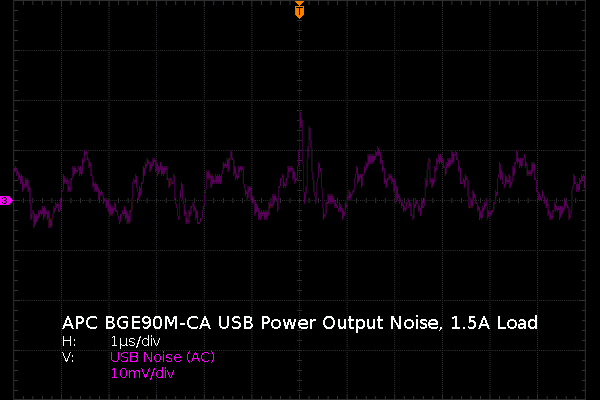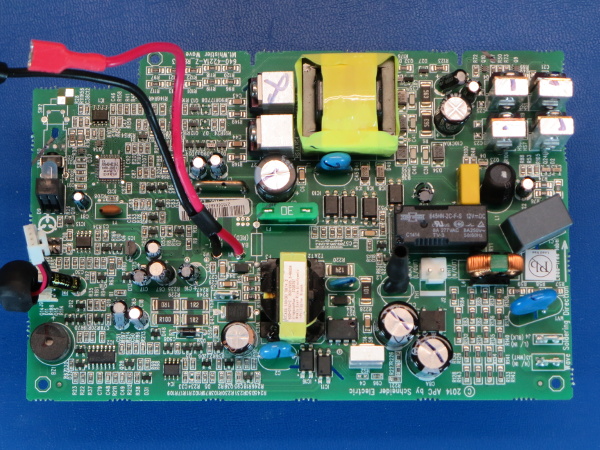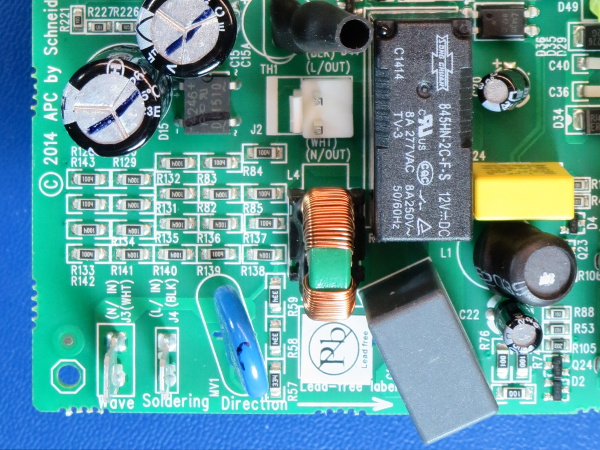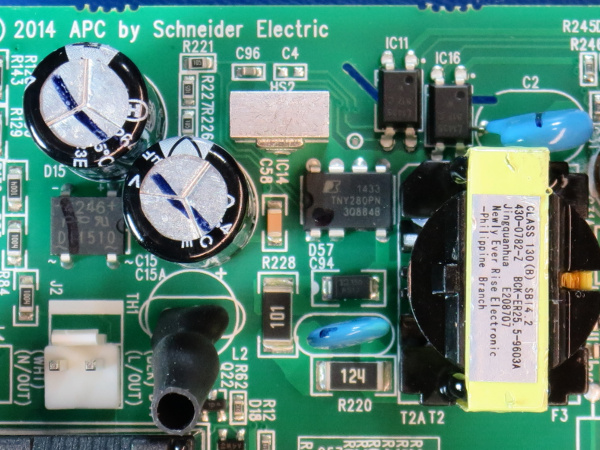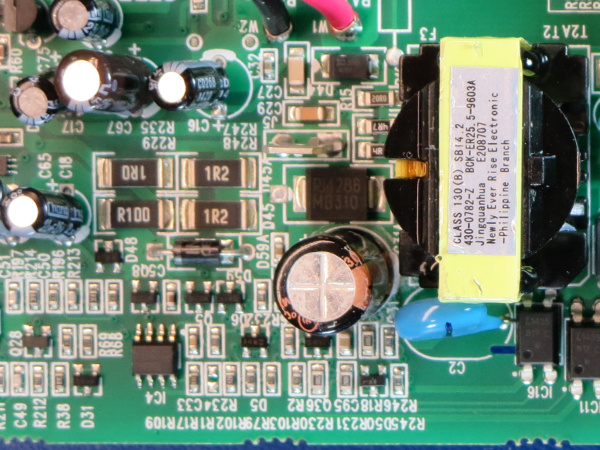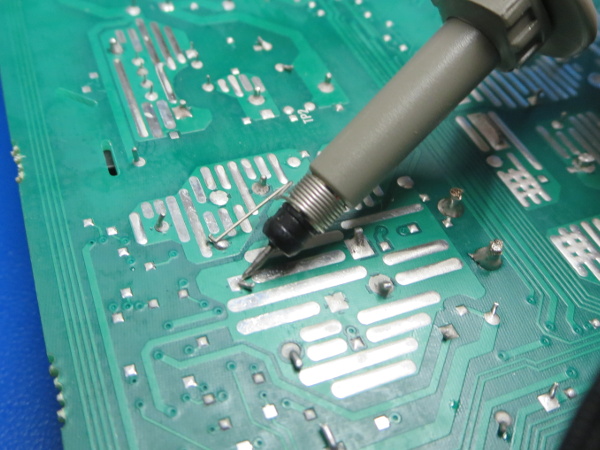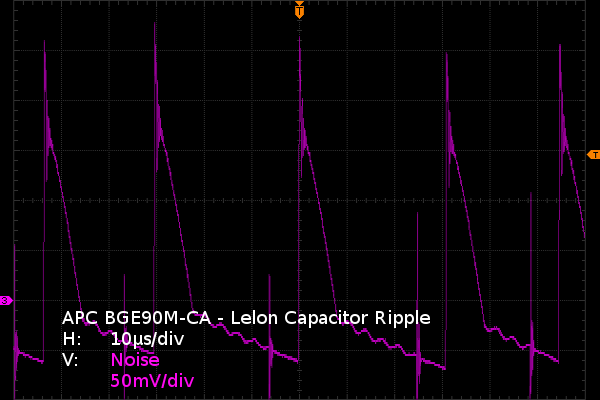APC BGE90M-CA UPS Tear-Down
USB Power Board – Top
This “Mt. Whistler II” board has a couple of chunky ceramic capacitors before and after the PS54425 buck regulator chip rated for up to 4A, tons of ground plane area to heat-sink that chip, a generous amount of via stitching to transfer heat to the bottom, and a pair of SOT23-5 USB power switches with unreadable part numbers, providing over-current protection and possibly over-voltage disconnect, each followed by an aluminum capacitor. A typical $1 Chinese DC-DC USB adapter won’t have half as many components, and it'll rely entirely on the regulator’s internal current limit instead of using dedicated protection ICs.
Every through-hole component and the bulky surface-mounted inductor also get the squiggle treatment.
USB Power Board – Bottom
Quality does not stop at the component count and protection on the top side. To keep output noise low, the input and output grounds meet at a single point next to the chip, and the ground plane covering most of the bottom makes the whole board act as a heat sink.
The only flaw I can see in this design is the power trace for the 1A USB port. See that fat horizontal trace near the middle of the board? Vias on the right have been doubled and tinned to provide extra current-carrying capacity, but are not matched on the left where only a single via covered in solder mask can be found. There should have been two vias there, preferably tinned to match the other end.
USB Power Measurements
How good are the USB outputs? It's time to dust off my shunt regulator from last year and find out. I got 1.1A on the 1A port and 1.4A on the 1.5A port before voltage at the port dipped below 5V from 5.15V open-circuit voltage. With the shunt tweaked to 1.5A from the 1.5A output, I connected my oscilloscope and found about 30mVPP worth of noise on there. That's not quite as good as my original N7 AC adapter or the LX1500, but still much better than most third-party adapters you can get under $10.
Considering that these USB power outlets are a bonus feature on a $30 UPS, I’d call our measurements mildly impressive.
Main Board – Top
As I wrote earlier, this is one busy little board, at least from the top side. Power comes in from the bottom-right corner where basic filtering and the bypass relay live. It feeds the power supply in the bottom-middle. And the analog magic happens mainly in the bottom-left corner, while digital goodies occupy the upper-left corner. The remaining components in the top-right quadrant make up the power stage of this electronic inverter.
Get Tom's Hardware's best news and in-depth reviews, straight to your inbox.
Power Input
In the input section, AC power comes in through the two spade connectors in the bottom-left corner, passes by the 14D471K MOV, through a small common-mode choke, hits a 1µF X-class capacitor, then goes off to power the loads through the bypass relay and internal electronics.
What's with the large number of small resistors? They make up four voltage dividers used to monitor input and output voltage. Why so many? Because sensing is done without isolation, which means that if the divider network fails before anything else causes you to scrap the UPS first, you can end up with full AC voltage on the USB outputs. Take the required number of resistors based on their voltage withstanding specification and double that for safety.
APC’s labeling tradition continues: every power terminal, connector, or wire is marked with component designator, wire color, and wire function.
Power Supply – Primary Side
In the BGE90’s power supply primary side, we find an NTC inrush-limiting resistor hidden in a piece of heat-shrink tubing, a rectifier bridge in DIP6-4 packaging, a pair of Jianghai (“JH”) CD264 22µF 400V capacitors for the input energy reservoir, a Power Integration TNY280 monolithic flyback regulator, an RCD snubber circuit for the transformer’s primary winding, a pair of 817C photo-couplers, and a Y-class capacitor.
Information on Jianghai capacitor reliability is scarce despite the company having been around since 1958, which hopefully means there aren’t many failures that get traced back to them.
What Is That HS2 Component?
HS2 is exactly what its designator implies: just a heat sink. While the TNY280 controller is capable of providing up to 28W, it requires some thermal assistance to do so across its full 85-240VAC range in an enclosed area. Help comes in the form of a small sink close to the TNY’s four source pins and copper pours on both sides of the circuit board to help move heat along.
Power Supply – Secondary Side
On the secondary side, we have an MB310 diode, a 330µF 35V Lelon RXK capacitor, and a handful of low-value resistors to measure battery charging current, which would explain why the feedback circuit contains two 817C opto-couplers. One provides current limiting during charging, while the other provides float voltage regulation.
I do not like that Lelon capacitor. On top of being a brand near the bottom of the reputation ladder, the capacitor APC uses is only rated for 1ARMS. This does not bode well in a flyback application, especially if people choose to use the USB ports to continuously power 10W worth of devices.
Probing For Answers
After triple-checking that the only connection between the low-voltage side and mains was through those mega-ohm resistor strings, I concluded that it would be relatively safe (as safe as poking around live line-powered equipment gets) to directly probe the capacitor and peek at how much ripple voltage it actually sees.
How Much Ripple?
For testing purposes, I am drawing 1.5A from the USB power outlet once again. According to Lelon’s datasheet, the capacitor has an impedance better than 0.062Ω and is almost entirely to blame for the ~250mVPP worth of ripple seen here. Decomposing the waveform into triangles to approximate its RMS value yields about 36mVRMS and divided by the capacitor’s impedance, we get 580mARMS of ripple current. While this is within the capacitor’s rating, it is far from what it could have been with a better-quality capacitor. As I have written in the past, flyback and boost converters are cruel taskmasters to their capacitors.
MORE: CyberPower CP1000PFCLCD Tear-Down
MORE: APC BE550G Tear-Down
MORE: Tripp-Lite SMART1000LCD Tear-Down
-
gamebrigada For 30 bucks I'm not super concerned about the capacitors. The soldering job is decent and not done by a shmuck, and the board is nicely designed and doesn't look like it was designed by a 5 year old. Low quality capacitors scare me less than a potential fire.Reply -
nukemaster Another good read.Reply
Thanks.
I looked at this(something from the same family at least) for a cordless phone backup/router/ect, but slightly larger units did not cost much more. I did not see these for 30 dollars in my area. -
Daniel Sauvageau Reply
You're welcome!18333740 said:Another good read.
Thanks.
$30 was a clearance sale price. These units were manufactured in 2014, someone must have discovered pallets worth of these in the back of a warehouse somewhere and wanted to get rid of stale stock. At $30, these were almost worth getting just to scavenge the battery. The regular retail price is $47. While I was proofreading Chris' edits, I noticed the Newegg(.com) banner advertising a BGE90 for $80. I don't see stuff being so much cheaper in Canada than the USA very often. At such a large price discrepancy, it is almost worth it for US residents to order these units from Canada even before accounting for the exchange rate.18333740 said:I looked at this(something from the same family at least) for a cordless phone backup/router/ect, but slightly larger units did not cost much more. I did not see these for 30 dollars in my area.
New 600-650VA variants of this unit (BE600M1 and BN650M1) were launched last month (June 2016) and are only a few centimeters longer. They do cost $90-100 CAN though and at that price, it may make more sense on my side of the border to buy a pair of BGE90Ms and split the load.
BTW, there was an 8h long power outage at my mother's place due to trees shorting power lines out during a severe thunderstorm last week. The BE550G held out for about 2h30, twice as long as I was expecting it to based on its packaging's runtime chart. I'm glad it held up so much longer than planned since my mother waited until about 1h30 into the outage before calling me. The battery should have been dead by then based on the chart. Apparently, I hadn't made it clear enough the first time around before I set her up with VoIP to save her $40/month on phone bills that one key disadvantage of a VoIP setup is that dead UPS battery = no internet = no phone so if she waits to call, she may no longer be able to do so by the time she decides to. Maybe I should replace the 550 with a Frankenstein BGE90 connected to an external 12AH battery, should last over 10 hours. If voip.ms has a feature to send an email or call a number when an account fails to register for more than 15 minutes, I need to set that up. -
razor512 Why aren't they giving these devices li-ion batteries? The whole thing is lower drain, thus no super high end battery is needed to handle a very high current.Reply -
Daniel Sauvageau Reply
Lead-acid batteries are cheaper and can safely tolerate a whole lot more abuse than lithium cells do.18334228 said:Why aren't they giving these devices li-ion batteries?
-
alextheblue Reply18333740 said:BTW, there was an 8h long power outage at my mother's place due to trees shorting power lines out during a severe thunderstorm last week. The BE550G held out for about 2h30, twice as long as I was expecting it to based on its packaging's runtime chart. I'm glad it held up so much longer than planned since my mother waited until about 1h30 into the outage before calling me. The battery should have been dead by then based on the chart. Apparently, I hadn't made it clear enough the first time around before I set her up with VoIP to save her $40/month on phone bills that one key disadvantage of a VoIP setup is that dead UPS battery = no internet = no phone so if she waits to call, she may no longer be able to do so by the time she decides to. Maybe I should replace the 550 with a Frankenstein BGE90 connected to an external 12AH battery, should last over 10 hours. If voip.ms has a feature to send an email or call a number when an account fails to register for more than 15 minutes, I need to set that up.
It would be so much more efficient to be able to use a DC UPS though. Maybe get a 12V DC UPS and a couple of DC-DC adapters? :P -
Daniel Sauvageau Reply
I have entertained that idea a few times. The biggest hassle is getting the correct barrel connectors for everything you might want to connect to such an UPS and make sure you don't get leads mixed up between voltages and devices if you have devices that cannot tolerate 14V on their power input: if you have multiple 5x1.6mm barrel connector leads split between 5V devices and 12V devices, it would be quite easy to accidentally use the wrong lead on a 5V device and blow it up. I suspect this is the main reason why proper DC UPSes aren't widely available despite enabling much higher overall efficiency.18339557 said:It would be so much more efficient to be able to use a DC UPS though. Maybe get a 12V DC UPS and a couple of DC-DC adapters? :P
In principle, all you'd need to put one together for 30W worth of loads is a 3A 13V power supply to act as a float charger for the SLA battery with all the 12V loads connected to the battery and 5V USB adapters with sufficient output current for all the 5V stuff. -
alidan Reply18334174 said:
You're welcome!18333740 said:Another good read.
Thanks.
$30 was a clearance sale price. These units were manufactured in 2014, someone must have discovered pallets worth of these in the back of a warehouse somewhere and wanted to get rid of stale stock. At $30, these were almost worth getting just to scavenge the battery. The regular retail price is $47. While I was proofreading Chris' edits, I noticed the Newegg(.com) banner advertising a BGE90 for $80. I don't see stuff being so much cheaper in Canada than the USA very often. At such a large price discrepancy, it is almost worth it for US residents to order these units from Canada even before accounting for the exchange rate.18333740 said:I looked at this(something from the same family at least) for a cordless phone backup/router/ect, but slightly larger units did not cost much more. I did not see these for 30 dollars in my area.
New 600-650VA variants of this unit (BE600M1 and BN650M1) were launched last month (June 2016) and are only a few centimeters longer. They do cost $90-100 CAN though and at that price, it may make more sense on my side of the border to buy a pair of BGE90Ms and split the load.
BTW, there was an 8h long power outage at my mother's place due to trees shorting power lines out during a severe thunderstorm last week. The BE550G held out for about 2h30, twice as long as I was expecting it to based on its packaging's runtime chart. I'm glad it held up so much longer than planned since my mother waited until about 1h30 into the outage before calling me. The battery should have been dead by then based on the chart. Apparently, I hadn't made it clear enough the first time around before I set her up with VoIP to save her $40/month on phone bills that one key disadvantage of a VoIP setup is that dead UPS battery = no internet = no phone so if she waits to call, she may no longer be able to do so by the time she decides to. Maybe I should replace the 550 with a Frankenstein BGE90 connected to an external 12AH battery, should last over 10 hours. If voip.ms has a feature to send an email or call a number when an account fails to register for more than 15 minutes, I need to set that up.
have a costco where i live, they have 810 watt upses there for 100$ forget the brand name but remember them being good. if this costs 80 and the 810 costs 100, may as well get the significantly better one. -
Daniel Sauvageau Reply
If your objective is very long runtime, getting a massively higher VA rating UPS may not necessarily do you any good: in a traditional transformer-based inverter (every UPS I have shown here so far other than the BGE90 and BX1000), a larger transformer core means higher magnetizing current and other related losses which bleed off battery power. When I measured the CP1000AVRLCD, BX1000 and BGE90's no-load battery current draw, I got ~25W for the CP, ~7W for the BX1000 and ~2.5W for the BGE.18349342 said:have a costco where i live, they have 810 watt upses there for 100$ forget the brand name but remember them being good. if this costs 80 and the 810 costs 100, may as well get the significantly better one.
If your 810W UPS uses a traditional transformer-based inverter like the 1000AVRLCD does, it will need a battery about twice the size of the BGE90's to beat it at endurance on 10-15W loads due to wasting more power walking its large transformer core through its hysteresis loop than actually powering the loads.
Sometimes, less is more. The typical use-case for the BGE90 should be one of those cases when compared against UPSes using traditional inverters. -
alextheblue Reply18342170 said:
I have entertained that idea a few times. The biggest hassle is getting the correct barrel connectors for everything you might want to connect to such an UPS and make sure you don't get leads mixed up between voltages and devices if you have devices that cannot tolerate 14V on their power input: if you have multiple 5x1.6mm barrel connector leads split between 5V devices and 12V devices, it would be quite easy to accidentally use the wrong lead on a 5V device and blow it up. I suspect this is the main reason why proper DC UPSes aren't widely available despite enabling much higher overall efficiency.18339557 said:It would be so much more efficient to be able to use a DC UPS though. Maybe get a 12V DC UPS and a couple of DC-DC adapters? :P
In principle, all you'd need to put one together for 30W worth of loads is a 3A 13V power supply to act as a float charger for the SLA battery with all the 12V loads connected to the battery and 5V USB adapters with sufficient output current for all the 5V stuff.
Change the connectors on the units in question or glue them in and cut the cord, adding a second connector (something akin to a breakaway connector on an Xbox 360) that's different and incompatible for each device :P
Really I think that all small widgets and whatsits should just go USB Type C. :D Then it would be not only viable, but really easy. Heck at that point you'd basically be building a really high-class USB power bank.
